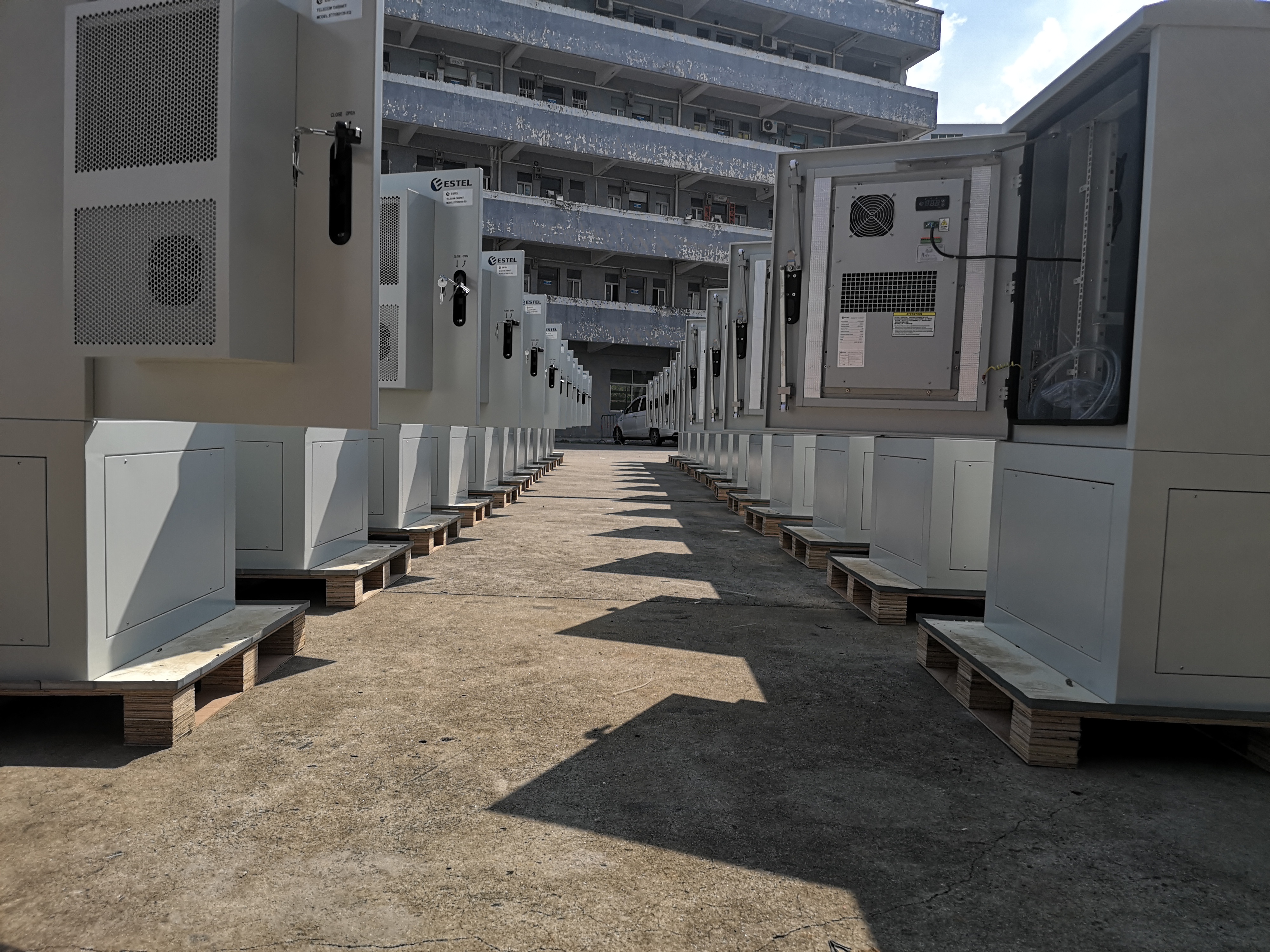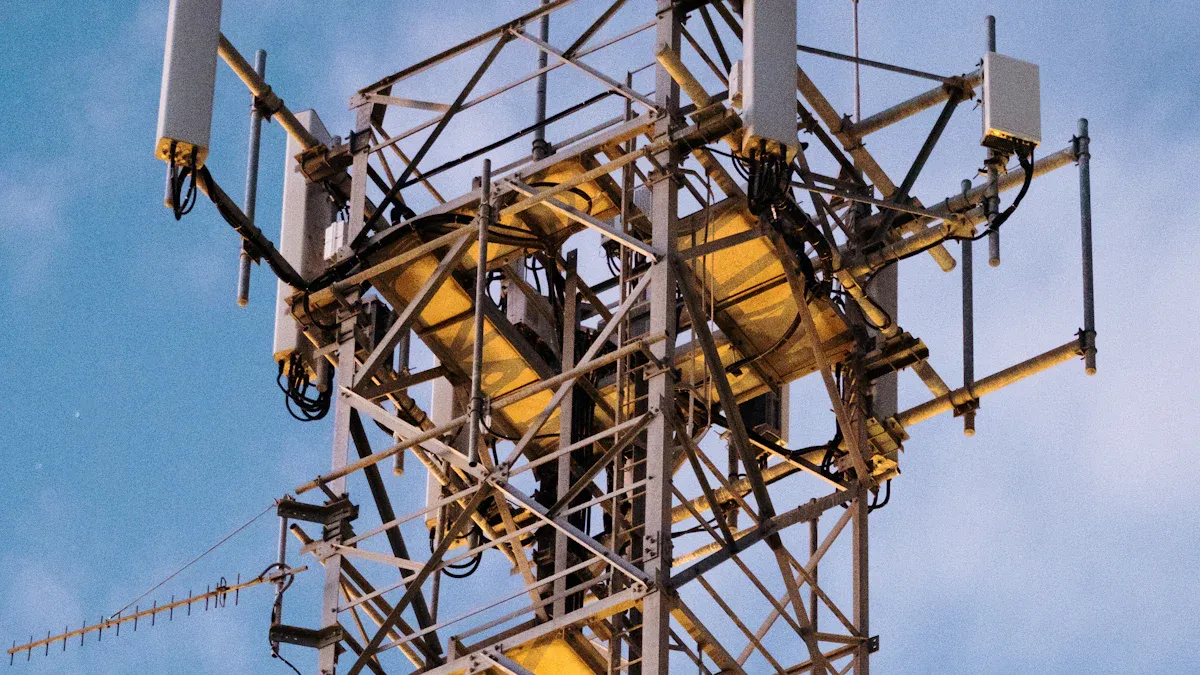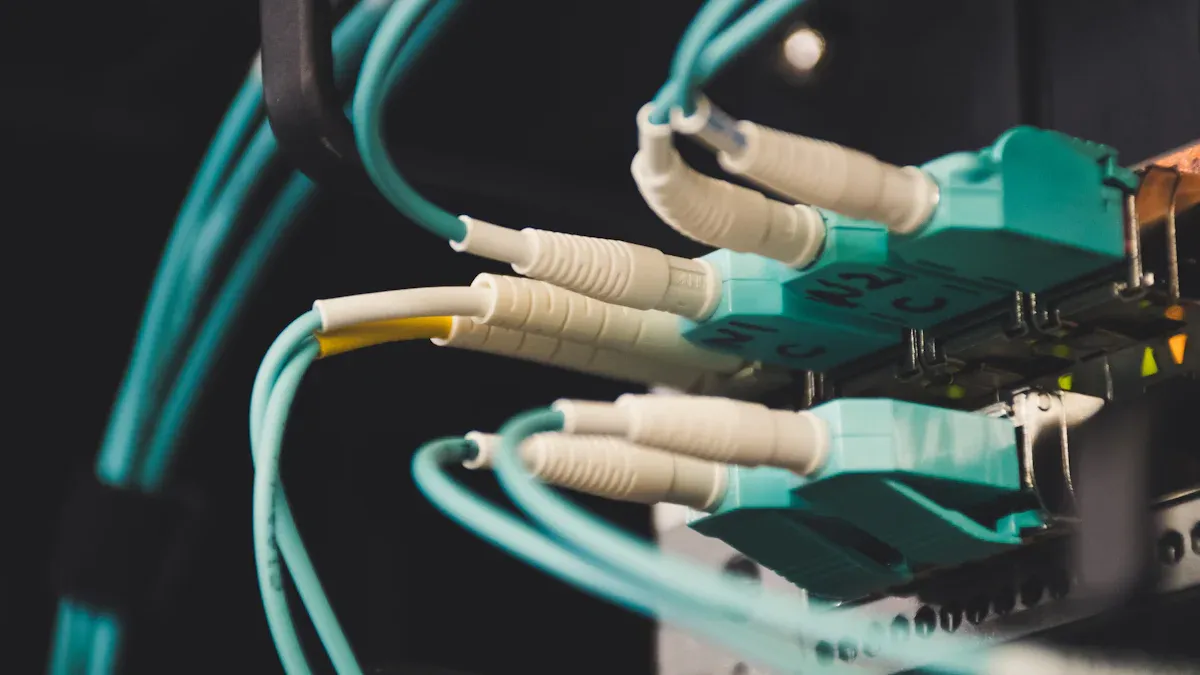How ESTEL Telecom Rectifier Modules Work in 2025

You rely on telecom systems every day, whether for communication, streaming, or staying connected. At the heart of these systems lies the ESTEL rectifier module telecom technology. This critical component ensures seamless power delivery by converting ac to dc power, a process essential for stable operation. In 2025, these modules play a pivotal role in supporting advanced telecom infrastructure. They ensure your networks remain efficient and reliable, even as demands for speed and connectivity grow.
Key Takeaways
Telecom rectifiers change AC power to DC, giving steady energy for communication systems.
ESTEL's rectifiers work with over 91% efficiency, saving energy and helping the environment.
Modern features like remote checks and easy-to-replace parts make them reliable and simple to fix.
These rectifiers are key for running 5G networks, handling high energy needs efficiently.
Picking ESTEL rectifiers helps telecom companies work better and protect the planet.
Understanding Telecom Rectifiers and Their Working Principles
What Is a Telecom Rectifier?
A telecom rectifier is a device that converts alternating current (AC) into direct current (DC). This conversion is essential for powering telecommunications equipment, which relies on a stable DC power supply to function effectively. Without rectifiers, telecom systems would face frequent disruptions, leading to unreliable communication networks.
Telecom rectifiers are widely used in various applications, including telecom towers, data centers, and 5G infrastructure. They ensure uninterrupted power delivery, even during voltage fluctuations or power outages. The global demand for telecom rectifiers continues to grow, with the market projected to reach USD 12.22 billion by 2032, driven by advancements in telecom technologies and the increasing adoption of 5G networks.
Did you know? The Asia-Pacific region is the fastest-growing market for telecom rectifiers, thanks to rapid technological advancements and expanding telecom infrastructure.
Rectifier Working Principle Explained
The rectifier working principle revolves around converting AC power, which alternates in direction, into DC power, which flows in a single direction. This process involves the use of diodes, which allow current to pass in one direction while blocking it in the opposite direction. Depending on the design, rectifiers can handle single-phase or three-phase AC inputs.
Here’s a breakdown of common rectifier types and their functions:
Type of Rectifier Module | Description |
|---|---|
Half Wave | Converts AC to DC using a single diode, allowing current to flow in one direction only. |
Full Wave | Utilizes multiple diodes to convert both halves of the AC waveform to DC. |
Three Phase | Employs three-phase AC supply for efficient power conversion. |
Single Phase | Uses a single-phase AC supply for rectification. |
Half Controlled | Allows partial control over the output voltage. |
Uncontrolled | Provides a fixed output voltage without control. |
Full Controlled | Offers complete control over the output voltage. |
Modern telecom rectifiers, like ESTEL's 2025 models, achieve efficiency levels of up to 97%, significantly reducing energy loss during the conversion process. This high efficiency translates into lower operational costs and improved sustainability for telecom operators.
Key Components of a Rectifier Module Telecom System
A rectifier module telecom system comprises several key components that work together to ensure reliable power conversion and delivery. These components include:
Input Transformer: Adjusts the incoming AC voltage to the required level for rectification.
Diodes or Thyristors: Perform the actual rectification by converting AC to DC.
Filters: Smooth out the DC output to eliminate ripples and ensure a stable power supply.
Control Circuitry: Monitors and regulates the rectifier's performance, ensuring optimal efficiency and reliability.
Cooling System: Prevents overheating by dissipating excess heat generated during operation.
Protection Mechanisms: Safeguard the system against over-voltage, short circuits, and other potential disruptions.
For example, ESTEL's rectifier modules feature advanced protection mechanisms and remote monitoring capabilities, allowing you to manage power systems efficiently from a distance. These features make them ideal for modern telecom applications, where reliability and scalability are critical.
Pro Tip: When selecting a rectifier module, consider factors like input voltage range, output power capacity, and efficiency to ensure compatibility with your telecom infrastructure.
Features of ESTEL's 2025 Telecom Rectifier Modules

Technological Advancements in ESTEL Rectifiers
In 2025, ESTEL's telecom rectifiers stand out due to their cutting-edge technology. These rectifiers utilize advanced zero current and zero voltage switching technology, which significantly enhances the conversion process. This innovation minimizes energy loss during the ac to dc transformation, achieving a high efficiency of over 90%. Such efficiency not only reduces operational costs but also supports sustainable telecom operations by lowering energy consumption.
Another notable advancement is the integration of intelligent monitoring systems. These systems allow you to remotely track and manage the rectifier module's performance. With real-time data on power usage, temperature, and system health, you can ensure optimal operation and quickly address any issues. This level of automation makes ESTEL's rectifiers ideal for modern telecom infrastructure, where reliability and efficiency are paramount.
Fun Fact: ESTEL's rectifiers are designed to operate seamlessly in extreme conditions, with an operating temperature range of -25°C to +55°C. This makes them suitable for deployment in diverse environments, from freezing mountain regions to scorching deserts.
Unique Features of ESTEL's Rectifier Module
ESTEL's rectifier modules come packed with features that set them apart in the telecom industry. These features ensure reliability, flexibility, and ease of use, making them a preferred choice for telecom operators. Here's a quick overview:
Feature | Description |
|---|---|
Ensures a power factor greater than 0.98 for efficient energy use. | |
AC Input Voltage Range | Operates within a wide range of 90~280Vac, ensuring compatibility. |
Efficiency | Achieves ≥90% efficiency with zero current/voltage switching technology. |
Battery Management | Includes charge/discharge management, temperature compensation, and more. |
Hot-swappable | Allows easy replacement without disrupting operations. |
Input Protection | Guards against over/under voltage issues. |
Output Protection | Protects against overvoltage, overcurrent, and short circuits. |
Current Sharing | Enables auto current sharing for parallel operation. |
Mounting | Designed for embedded mounting, saving space in telecom setups. |
These features make ESTEL's rectifier modules highly adaptable to various telecom applications. Whether you're managing a large-scale data center or a remote telecom tower, these modules provide the reliability and performance you need.
Energy Efficiency and Reliability in ESTEL Telecom Rectifiers
Energy efficiency and reliability are at the core of ESTEL's telecom rectifiers. With an efficiency rating of over 91%, these rectifiers minimize energy loss during the conversion process. This high efficiency reduces heat generation, which in turn lowers cooling requirements. As a result, you save on energy costs while contributing to a greener environment.
The active power factor compensation feature, with a power factor of 0.98, ensures optimal energy utilization. This reduces strain on the power grid and enhances the overall stability of your telecom infrastructure. Additionally, the compact design of these rectifiers makes them perfect for remote installations, where space and energy resources are often limited.
Pro Tip: By choosing ESTEL's rectifiers, you not only improve your system's performance but also reduce your carbon footprint. Their energy-efficient design helps telecom operators meet sustainability goals without compromising on reliability.
Reliability is another key strength of ESTEL's rectifiers. Advanced protection mechanisms safeguard the system against voltage fluctuations, short circuits, and other potential disruptions. This ensures uninterrupted power delivery, even in challenging conditions. With features like hot-swappable modules and intelligent battery management, you can maintain your telecom operations with minimal downtime.
Integration of ESTEL Rectifier Modules into Telecom Infrastructure

Role in Macrocells and Microcells
ESTEL rectifier modules play a vital role in powering macrocells and microcells, the backbone of modern telecom infrastructure. Macrocells, which cover large areas, require robust telecom rectifiers to handle high power demands. These rectifiers ensure a stable DC power supply, enabling uninterrupted communication across vast regions. On the other hand, microcells, designed for smaller coverage areas, benefit from the compact and efficient design of ESTEL’s rectifier modules. Their ability to deliver high efficiency and reliability makes them ideal for dense urban environments where space is limited.
By integrating ESTEL rectifiers, you can optimize the performance of both macrocells and microcells. These modules provide consistent DC power supplies, ensuring seamless operation even during power fluctuations. Their advanced protection mechanisms safeguard telecom systems from potential disruptions, enhancing overall reliability.
Supporting 5G and Advanced Networks
The deployment of 5G infrastructure demands telecom rectifiers that can handle increased power requirements. ESTEL’s Class 4 rectifiers are specifically designed to meet these challenges. They provide nearly double the power compared to previous generations, ensuring sufficient energy for 5G and advanced networks. This capability supports the high-speed data transfer and low latency required by modern telecom systems.
These rectifiers also enhance efficiency by enabling the use of lighter cabling, which reduces installation costs. Safety features, such as immediate power shutdown upon fault detection, protect technicians during maintenance. By incorporating ESTEL rectifiers, you can ensure your 5G infrastructure operates efficiently and safely, meeting the demands of next-generation networks.
Scalability and Flexibility in Telecom Deployment
Scalability and flexibility are crucial for modern telecom infrastructure. ESTEL rectifier modules excel in both areas, allowing you to adapt to changing network requirements. Their modular design supports easy expansion, enabling you to scale your telecom systems as needed. Whether you’re deploying a new network or upgrading an existing one, these rectifiers provide the flexibility to meet your goals.
The hot-swappable feature of ESTEL rectifiers ensures minimal downtime during maintenance or upgrades. This capability is particularly beneficial for telecom operators managing large-scale deployments. With ESTEL’s rectifier modules, you can achieve a balance between performance, reliability, and cost-effectiveness, ensuring your telecom infrastructure remains future-ready.
Key Benefits of ESTEL Telecom Rectifier Modules
Energy Efficiency and Cost-Effectiveness
ESTEL telecom rectifiers deliver exceptional energy efficiency, reducing operational costs for telecom operators. With a high efficiency of over 91%, these rectifiers minimize energy loss during the ac to dc conversion process. This efficiency not only lowers electricity bills but also reduces the need for extensive cooling systems, saving additional resources.
The active power factor compensation feature ensures optimal energy utilization, with a power factor greater than 0.98. This reduces strain on the power grid and enhances the stability of telecom infrastructure. By choosing ESTEL rectifiers, you can achieve a stable dc power supply while keeping costs under control.
Enhanced Reliability and Durability
Reliability is a cornerstone of ESTEL’s rectifier modules. These rectifiers are designed to withstand harsh environmental conditions, ensuring consistent performance in extreme temperatures ranging from -25°C to +55°C. Advanced protection mechanisms safeguard against voltage fluctuations, short circuits, and other disruptions, ensuring uninterrupted dc power supplies.
The modular design of these rectifiers allows for easy maintenance and scalability. Hot-swappable modules enable quick replacements without disrupting operations, making them ideal for critical telecom infrastructure. With ESTEL rectifiers, you can count on long-lasting durability and minimal downtime.
Environmental Sustainability in Telecom Rectifiers
ESTEL rectifiers contribute to environmental sustainability by incorporating energy-saving modes and intelligent monitoring systems. These features reduce energy consumption and operational costs, aligning with global sustainability goals. The modular design facilitates scalability, reducing waste during upgrades or expansions.
“A focus on dynamic programmable networks will be crucial for enhancing energy efficiency and sustainability. Matching network capacity with traffic demand can enhance performance without increasing energy consumption.”
Feature | Description |
|---|---|
High-Efficiency Rectifiers | Ensures reliable and efficient power delivery for telecommunications networks. |
Intelligent Monitoring | Allows for real-time performance tracking and management, enhancing sustainability. |
Modular Design | Facilitates easy scalability and maintenance, suitable for various deployment sizes. |
Energy-Saving Modes | Reduces operational costs and energy consumption, contributing to overall sustainability. |
Durability | Built to withstand harsh environmental conditions, ensuring consistent performance. |
By integrating ESTEL rectifiers into your telecom infrastructure, you not only improve efficiency and reliability but also support a greener future.
Future Trends in Telecom Rectifiers
AI and IoT Integration in Rectifier Modules
Artificial intelligence (AI) and the Internet of Things (IoT) are transforming how telecom rectifiers operate. These technologies enhance operational efficiency by enabling predictive maintenance and real-time monitoring. AI algorithms analyze data from rectifiers to predict failures and optimize performance. This reduces maintenance costs and improves reliability, ensuring a stable DC power supply for telecom systems.
IoT integration allows rectifiers to communicate with other devices in the network. This connectivity enables smarter power management and better energy efficiency. For example, IoT sensors can monitor environmental conditions and adjust the rectifier's output to match the system's needs. These advancements make telecom rectifiers more adaptable to the dynamic demands of modern networks.
Tip: By adopting AI and IoT-enabled rectifiers, you can reduce downtime and enhance the reliability of your telecom infrastructure.
Innovations in Power Conversion Technology
Recent innovations in power conversion technology are setting new benchmarks for efficiency and cost-effectiveness. A patented zero-voltage switching hybrid voltage divider has significantly improved energy conversion efficiency. This technology minimizes energy loss during the AC to DC conversion process, reducing operational costs for telecom operators.
Other advancements include solar cell configurations that use optical fibers to enhance light-to-electricity conversion. These technologies, initially developed for space applications, are now being adapted for commercial use. They address diverse power-related challenges, making them ideal for telecom systems that require reliable and efficient power solutions.
These innovations align with the rectifier working principle of converting AC to DC power while minimizing energy loss. By leveraging these technologies, you can achieve higher efficiency and sustainability in your telecom operations.
The Future Role of Telecom Rectifiers in Network Evolution
Telecom rectifiers will play a pivotal role in the evolution of telecom networks. As data traffic increases and 5G technology expands, the demand for reliable power solutions will grow. Rectifiers are essential for converting AC to DC power, which is crucial for telecom equipment operation.
The rectifier segment is expected to dominate the telecom power systems market. This is due to its critical role in providing high-quality DC power at telecom towers. Additionally, the modular design of modern rectifiers supports scalability, allowing you to adapt to changing network requirements.
Did you know? The growth of 5G technology will further increase the demand for rectifiers, making them indispensable for future telecom networks.
ESTEL telecom rectifier modules are essential for powering modern telecom systems in 2025. They provide reliable and efficient energy conversion, ensuring uninterrupted operations for advanced networks like 5G. By integrating these modules, you can enhance your infrastructure's performance while reducing energy costs. Their innovative features also support sustainability, making them a smart choice for future-ready telecom solutions.
Note: Choosing ESTEL rectifiers helps you stay ahead in a rapidly evolving industry while contributing to a greener planet.
FAQ
What is the primary purpose of a telecom rectifier module?
A telecom rectifier module converts alternating current (AC) into direct current (DC). This ensures a stable power supply for telecom equipment, enabling uninterrupted communication and reliable network performance.
How do ESTEL rectifiers improve energy efficiency?
ESTEL rectifiers use advanced zero current and zero voltage switching technology. This minimizes energy loss during power conversion, achieving efficiency levels of over 90%. You save on energy costs while reducing environmental impact.
Can ESTEL rectifiers handle extreme environmental conditions?
Yes, ESTEL rectifiers operate in temperatures ranging from -25°C to +55°C. Their robust design ensures reliable performance in harsh environments, including remote or extreme locations.
Are ESTEL rectifiers compatible with 5G networks?
Absolutely. ESTEL rectifiers meet the high power demands of 5G infrastructure. They provide efficient energy conversion and scalability, making them ideal for supporting advanced telecom networks.
What makes ESTEL rectifiers easy to maintain?
Their modular design and hot-swappable features simplify maintenance. You can replace components without disrupting operations, ensuring minimal downtime for your telecom systems.
See Also
Understanding The ESTEL Power System For Telecom Cabinets
Exploring ESTEL's Energy Storage System For Telecom Cabinets
Ensuring Optimal Voltage Levels In ESTEL Communication Cabinets
The Role Of Energy Storage Batteries In ESTEL Cabinets
Integrating Photovoltaic Inverters With Telecom Cabinet Battery Systems
CALL US DIRECTLY
86-13752765943
3A-8, SHUIWAN 1979 SQUARE (PHASE II), NO.111, TAIZI ROAD,SHUIWAN COMMUNITY, ZHAOSHANG STREET, NANSHAN DISTRICT, SHENZHEN, GUANGDONG, CHINA


